Pitlochry: Difference between revisions
Created page with '{{Infobox town |name=Pitlochry |gaelic=Baile Chloichridh |county=Perthshire |picture=Ben Vrackie and Pitlochry.jpg |picture caption=Pitlochry beneath Ben Vrackie |os grid ref= NN…' |
mNo edit summary |
||
| Line 25: | Line 25: | ||
==Dam and Fishladders!== | ==Dam and Fishladders!== | ||
[[File:Pitlochry Fish-ladder.JPG|thumb|The Pitlochry fish ladder]] | [[File:Pitlochry Fish-ladder.JPG|thumb|200px|The Pitlochry fish ladder]] | ||
Signposted by Pitlochry is "Dam and Fish Ladder", and by them is Loch Faskally, all of which attract visitors. The dam was built as a hydro-electric power scheme, and created an artificial loch, [[Loch Faskally]]. To allow salmon to continue to swim to their spawning ground in the upper reaches of the river, a 1,017-foot fish ladder was built. Visitors can stand in an underwater viewing station and watch fish swimming from weir to weir within the ladder, or by a video link from inside the visitor centre. Over 5,000 salmon pass through annually. | Signposted by Pitlochry is "Dam and Fish Ladder", and by them is Loch Faskally, all of which attract visitors. The dam was built as a hydro-electric power scheme, and created an artificial loch, [[Loch Faskally]]. To allow salmon to continue to swim to their spawning ground in the upper reaches of the river, a 1,017-foot fish ladder was built. Visitors can stand in an underwater viewing station and watch fish swimming from weir to weir within the ladder, or by a video link from inside the visitor centre. Over 5,000 salmon pass through annually. | ||
| Line 41: | Line 41: | ||
==Parish church== | ==Parish church== | ||
[[File:Pitlochry church 2007.jpg|thumb|The Old Church of Rannoch and Tryst]] | [[File:Pitlochry church 2007.jpg|thumb|200px|The Old Church of Rannoch and Tryst]] | ||
The village has two churches: | The village has two churches: | ||
Latest revision as of 13:47, 8 December 2010
| Pitlochry Gaelic: Baile Chloichridh | |
| Perthshire | |
|---|---|
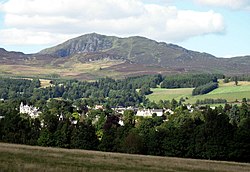 Pitlochry beneath Ben Vrackie | |
| Location | |
| Grid reference: | NN941582 |
| Location: | 56°42’18"N, 3°43’59"W |
| Data | |
| Population: | 2,564 |
| Post town: | Pitlochry |
| Postcode: | PH16 5 |
| Dialling code: | 01796 |
| Local Government | |
| Council: | Perth and Kinross |
| Parliamentary constituency: |
Perth and North Perthshire |
| Website: | www.pitlochry.org |
Pitlochry is a highland town in Perthshire, lying on the River Tummel, with a population according to the 2001 census of 2,564.[1]
The town is largely Victorian. Its prosperity as a tourist resort was due to Queen Victoria's visiting the area in 1842, and the arrival of the railway in 1863.
The town remains a popular tourist resort today and is particularly known as a centre for hillwalking, surrounded by mountains such as Ben Vrackie and Schiehallion. The rivers are rich in fish, attracting anglers. It is popular as a base for coach holidays.
The town has retained many stone-built Victorian buildings and the main street has an unusual period cast iron canopy over one side.
Dam and Fishladders!
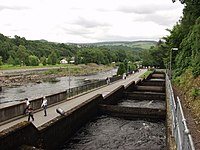
Signposted by Pitlochry is "Dam and Fish Ladder", and by them is Loch Faskally, all of which attract visitors. The dam was built as a hydro-electric power scheme, and created an artificial loch, Loch Faskally. To allow salmon to continue to swim to their spawning ground in the upper reaches of the river, a 1,017-foot fish ladder was built. Visitors can stand in an underwater viewing station and watch fish swimming from weir to weir within the ladder, or by a video link from inside the visitor centre. Over 5,000 salmon pass through annually.
History
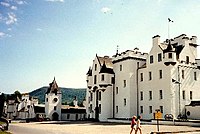
Pitlochry as it exists today dates largely from Victorian times although the areas known as Moulin and Port-na-craig are much older. History records that Moulin Kirk was granted by the Earl of Atholl to Dunfermline Abbey in 1180 and Moulin became a burgh of barony in 1511. Port-na-craig was the site of the original ferry over the River Tummel which operated until the suspension footbridge was built in 1913. Building between these two separate communities followed the construction of the military road north in the 18th century which followed the line of the present main street.
In 1842 Queen Victoria visited Perthshire on one of her grand tours and her favourable opinion of the area caused the town to be more widely noticed. After the railway station was built in 1863, Pitlochry became a favoured destination for tourists.
In 1947 Pitlochry became a burgh. That year also saw the beginning of construction of a dam as part of the Tummel hydro-electric power scheme. The dam and its fish ladder are a popular tourist attraction today. The damming of the river created an artificial loch, Loch Faskally but it flooded a large area north of the town including the old Recreation Park which was relocated to its current position.
Pitlochry Festival Theatre[2] was founded by the visionary John Stewart in 1951, originally situated in a tent in the grounds of Knockendarroch House in Lower Oakfield. The tent became semi-permanent and remained there for 30 years until the current building at Port-na-craig opened in 1981.
The town was awarded a Gold Medal in the 2009 Britain in Bloom horticultural contest, and outright winner in the category of Small Town.[3]
Parish church
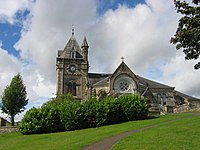
The village has two churches:
- Church of Scotland: The Old Church of Rannoch
- Scottish Episcopal Church: All Saints
The parish church is The Old Church of Rannoch. The church was one of Thomas Telford's Parliamentary Churches built in 1829 at a cost of £1,473 including the manse and a byre.
Unlike many of the Parliamentary Churches, the Old Church of Rannoch is shaped as a rectangular box with its focus at the east end under a high wood-clad ceiling, a difference resulting from a major reconstruction in 1893. The west gable was once home to a rose window whose outline can still be seen in the stonework. Today this gable provides entrance to the church.
Economy
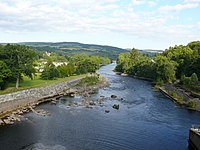
Pitlochry's main tourist attraction is its setting, with the surrounding mountains attracting hillwalkers and climbers. Other outdoor activities, such as angling and boating, are also popular. Being in the geographical centre of Scotland, it is a popular touring base.
The town has two whisky distilleries, whose visitor centres are popular attractions: Edradour, which is the smallest distillery in Scotland, and Blair Athol Distillery,[4] which dates back to 1798. Edradour sits to the north of town at the foot of the Moulin Moor. It is privately owned and produces only 12 casks per week with a production workforce of three men. Unchanged since it started making whisky it is the last example of a traditional distillery and hugely popular with visitors. Blair Athol sits on the main road at the east of town and since 1933 has been owned by Bell's, now part of the Diageo group. Its visitor facilities are state of the art.
The hydroelectric power station and its dam were completed in 1951 as the last link in the Tummel Valley hydro scheme which comprises nine power stations and reservoirs. The new reservoir which was named Loch Faskally was built across the River Tummel flooding a large area upstream. The concrete dam incorporates massive steel floodgates to control water levels with a walkway across the top with viewing windows to the powerhouse. Despite considerable local opposition to the construction of the new loch and power station it which became an instant attraction and now includes a visitor centre explaining hydro generation and the life of the gangs of workmen who built the schemes. The chain of reservoirs and dams has been a great help in controlling the flooding problems of the Tay valley to the east.
Arts and culture
Pitlochry has a repertory theatre (with a seating capacity of 544),[5] Pitlochry Festival Theatre, founded by John Stewart former director of Skerry's College.[6] Its ensemble company is the largest in Scotland. Its vision is "Stay Six Days and See Six Plays".
The renowned sound and light show, The Enchanted Forest,[7] takes place in Pitlochry's nearby Faskally Wood every year in October, attracting 20,000 visitors to the town.